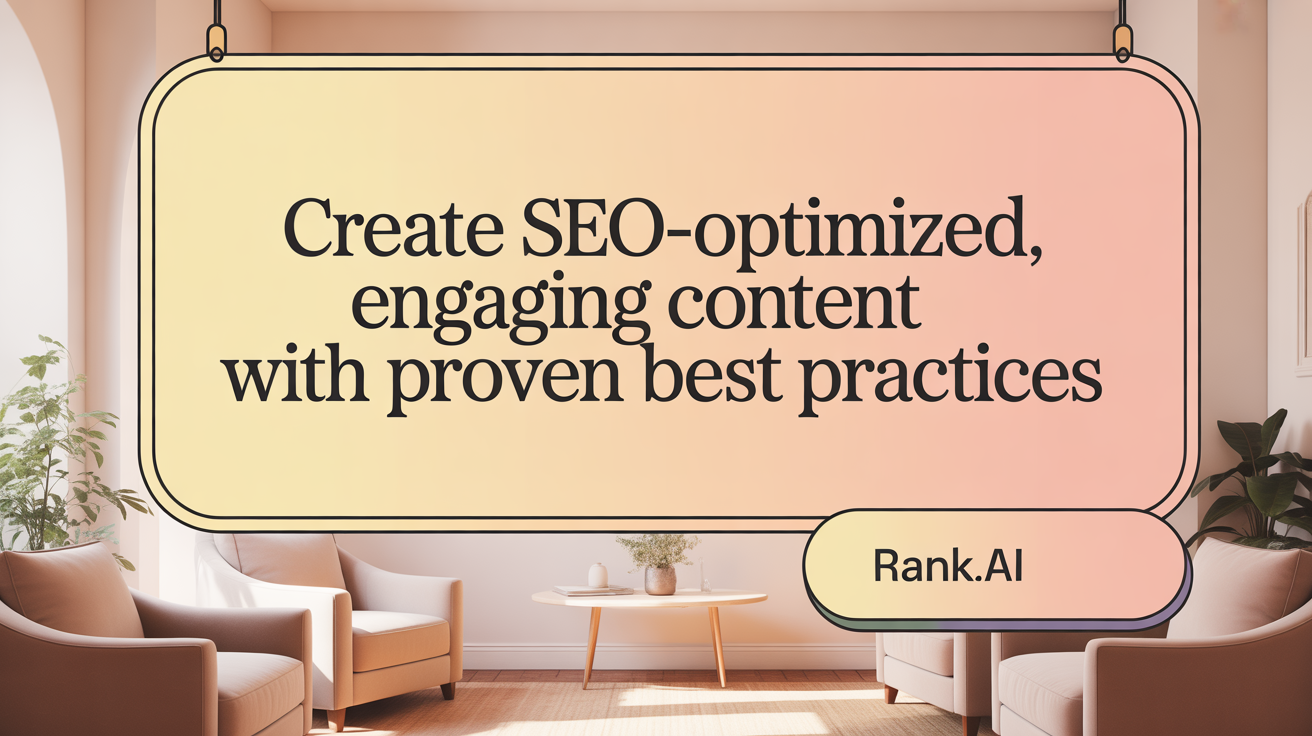Why Content Quality is Paramount in SEO Today
In the evolving landscape of digital search, content quality has emerged as a pivotal element determining SEO success. Search engines like Google continue to refine their algorithms to reward websites that provide valuable, relevant, and trustworthy information. Understanding the integral role content quality plays in SEO can empower marketers, writers, and businesses to optimize their strategies effectively, drive organic traffic, and build lasting authority online.
The Fundamental Importance of Content in SEO

What is the importance of content in SEO?
Content plays a crucial role in SEO because it serves as the foundation for how search engines evaluate and rank web pages. Well-crafted, relevant content helps search engines understand what a page is about, which increases the likelihood of it being indexed and ranked higher in search results.
High-quality content enhances user experience by providing valuable, engaging, and informative information that answers visitors’ questions. When users find content helpful, they tend to stay longer on the site, interact more, and even share the content, all of which are positive signals to search engines.
Regularly producing original and detailed content can also attract backlinks from other reputable sites, boosting the authority and credibility of your website. This not only improves your search rankings but also drives more organic traffic.
Another vital aspect is how content addresses different stages of the buying funnel — from awareness to decision-making. Tailored content that meets user needs at each phase can guide visitors along their journey, increasing conversions and revenue.
In summary, content is essential for SEO success because it helps search engines understand your site, engages users, builds trust through quality information, and encourages actions that improve your search engine visibility and overall online presence.
SEO's Role in Crafting Modern Content

What is the role of SEO in modern content writing?
In today's digital landscape, SEO is fundamental to creating content that is both discoverable and impactful. It helps ensure that high-quality content reaches the right audience by making it easier for search engines to identify relevance and authority.
Effective SEO techniques—such as strategic keyword placement, optimizing meta tags, and structuring content with clear headings—boost the likelihood of ranking higher in search engine results pages (SERPs). This increased visibility not only drives organic traffic but also builds credibility, trust, and authority within a niche.
Moreover, SEO aligns content with what users are actively searching for. By understanding search behaviors and intent, content creators can produce material that resonates better with the audience, encouraging higher engagement metrics like longer dwell time and more shares.
For writers and marketers, an understanding of SEO fundamentals is indispensable. It allows them to craft content that fulfills both user needs and search engine requirements, resulting in better rankings and more meaningful interactions.
In essence, SEO transforms traditional content into a powerful tool for growth—helping brands stand out, connect with their audience, and achieve their digital marketing goals.
Content Quality: The Cornerstone of SEO Success

What characteristics define high-quality content?
High-quality content stands out because it is relevant, original, comprehensive, and engaging. It addresses the specific needs and questions of the target audience, providing in-depth insights and accurate information. Well-structured writing, including clear headings, concise paragraphs, and visual elements like images and videos, enhances readability. Content that offers unique perspectives or expert analyses further adds value, making it more authoritative. To resonate with users and search engines alike, it’s also important that content is properly optimized with natural keyword integration, relevant metadata, and internal links, all contributing to its overall quality.
How do the E-E-A-T principles influence SEO?
The E-E-A-T model, which stands for Experience, Expertise, Authority, and Trustworthiness, significantly impacts how Google evaluates content. Content showcasing real-world experience and specialized knowledge demonstrates credibility. Authoritative content backed by reputable sources and transparent author credentials increases trust. Adhering to E-E-A-T principles ensures content aligns with Google's quality standards, improving chances of ranking higher in search results. Although these factors are not direct ranking signals, they shape the overall assessment and perception of content’s reliability.
What impact does quality content have on credibility, authority, and rankings?
High-quality content builds trust and establishes authority within a niche or industry. It encourages backlinks from other reputable websites, which are endorsements that boost domain authority. Enhanced trust and perceived expertise lead to better user engagement, including longer dwell times and lower bounce rates. Search engines interpret these engagement signals as indicators of content value, positively influencing rankings. Consistently delivering high-quality, updated content signals to search engines that a website remains relevant and authoritative, which is crucial for maintaining and improving rankings in competitive landscapes.
How does user engagement reflect content quality?
Engagement metrics such as dwell time, click-through rate, and bounce rate serve as indicators of content effectiveness. When visitors find content valuable, interesting, and easy to digest, they tend to spend more time on the page, share it, or explore other pages on the site. These behaviors tell search engines that the content fulfills user intent and provides genuine value. Regularly improving content based on user interactions, feedback, and evolving search trends ensures ongoing engagement and reinforces the website’s relevance and quality.
| Aspect | Effect | Example/Detail |
|---|---|---|
| Relevance | Meets user intent | Answering common questions in detail |
| Originality | Differentiates from competitors | Including unique data or insights |
| Depth | Provides comprehensive coverage | Covering all aspects of a topic |
| Readability | Easy to scan and understand | Well-formatted, clear language |
| Engagement | Increases user interaction | Multimedia, storytelling, calls-to-action |
| Optimization | Better visibility | Proper keywords, metadata, internal links |
| Credibility | Builds trust | Citing reputable sources, author credentials |
Creating high-quality content isn’t just about writing well—it is about delivering value in a way that meets search engine standards and exceeds user expectations. By consistently focusing on relevance, depth, and trustworthiness, content creators can drive sustained SEO success, attract organic traffic, and establish lasting authority in their niche.
Best Practices for Creating High-Quality SEO Content

How can you create high-quality content optimized for SEO?
Creating top-tier SEO content involves multiple strategic steps. Begin with comprehensive keyword research to discover what your target audience is searching for. This foundational step ensures your content aligns with user intent and topics of interest.
Next, focus on delivering valuable, accurate, and well-researched information that genuinely assists users. Original insights, deep analysis, and credible sources reinforce your content's authority and trustworthiness.
Structuring your content effectively is crucial. Use clear headings, subheadings, bullet points, and visuals to improve readability and keep users engaged. Concise, compelling writing that directly answers questions enhances user experience.
Apply on-page SEO techniques by optimizing titles, meta descriptions, and inserting relevant keywords naturally within your content. Use internal links to guide visitors through related topics on your site and external links to authoritative sources, boosting credibility.
Finally, keep your content fresh and relevant by regularly updating it. This demonstrates authority, improves visibility in search rankings, and sustains user interest. Consistent monitoring and revision ensure your content stays aligned with evolving search trends and user needs.
Effective Strategies to Produce SEO-Optimized Content
Conducting keyword research and search intent analysis
A crucial first step in creating SEO-friendly content is thorough keyword research. This process involves identifying the specific words and phrases your target audience uses when searching for products, services, or information related to your niche. Understanding search intent — whether informational, navigational, transactional, or commercial — helps tailor your content to meet what users are genuinely looking for. Incorporating the right keywords naturally into your content ensures relevance and boosts visibility.
Crafting compelling titles and headlines
Your titles and headlines serve as the first impression and play a significant role in attracting clicks. Effective titles should include targeted keywords, clearly state the value offered, and appeal to curiosity or urgency. Using engaging language and ensuring the headline accurately reflects the content builds trust and encourages users to explore further.
Organizing content for readability and engagement
Well-structured content improves user experience and keeps visitors engaged. Use clear headings, subheadings, bullet points, and short paragraphs to enhance readability. Incorporate visuals such as images, videos, and infographics to illustrate points and break up text. A logical flow, combined with internal links to related pages, helps users navigate your site easily, increasing dwell time — a positive signal for search engines.
Demonstrating expertise and trustworthiness
Google and other search engines emphasize authority and credibility through the E-E-A-T framework — Experience, Expertise, Authority, and Trustworthiness. Show your knowledge by citing reputable sources, providing accurate and detailed answers, and sharing original insights or research. Include author bios, credentials, and case studies to reinforce your authority, and ensure all information is factually correct and up-to-date.
Content promotion and consistent updates
Creating high-quality content is just the beginning. Promote your content across social media, email newsletters, and relevant online communities to increase reach. Regularly updating your content keeps it relevant and competitive, especially for trending or time-sensitive topics. Use tools like Google Search Console or analytics platforms to measure performance — focusing on metrics like organic traffic, bounce rates, and user engagement. Continually refine your strategy based on these insights.
| Strategy Area | Best Practices | Impact |
|---|---|---|
| Keyword & Search Intent | Research, analyze, target relevant keywords, understand user intent | Higher relevance, improved rankings |
| Title & Headline Crafting | Use keywords, be engaging, reflect content accurately | Increased CTR and user trust |
| Content Organization | Clear structure, visuals, internal linking | Better user experience, longer engagement |
| Credibility & Authority | Cite trusted sources, showcase expertise, update regularly | Enhanced credibility, higher rankings |
| Promotion & Updates | Share widely, update content routinely | Increased visibility, sustained relevance |
Incorporating these strategies ensures your content remains valuable, trustworthy, and optimized for search engines. Focus on your audience's needs, maintain quality, and adapt continually to stay ahead in the ever-evolving SEO landscape.
The Impact of Content Updates and Freshness on SEO Performance
How do content updates and freshness influence SEO performance?
Regularly refreshing website content plays a vital role in SEO success. Search engines, especially Google, favor fresh, relevant, and well-maintained content because it indicates that a website is active and authoritative. Fresh content not only improves a site's visibility but also increases user engagement, as visitors are more likely to trust and revisit sites that provide up-to-date information.
Google’s algorithms include features like the Freshness Update and Query Deserving Freshness (QDF), which help prioritize recent and current content in search results. When you update your website content regularly—adding new information, refining existing articles, or optimizing for trending keywords—you signal to search engines that your site is a reliable source of current information.
Content updates can take various forms: incorporating latest statistics, expanding on previous topics, fixing outdated links, or improving readability and user experience. These efforts boost relevance and can lead to higher rankings, increased organic traffic, and better engagement metrics, such as longer dwell times and lower bounce rates.
However, the importance of freshness differs based on the nature of the query. News-related or trending topics benefit immensely from frequent updates, while evergreen content remains valuable even with less frequent changes. Overall, maintaining an active and relevant content strategy is essential for staying competitive in search results.
Emerging Trends and Future Directions in Content Quality for SEO
What are current trends and future considerations in content quality for SEO?
The landscape of SEO is constantly evolving, placing increasing importance on the overall quality and relevance of content. Currently, search engines prioritize content that closely matches search intent through well-crafted, user-centric information. User engagement metrics such as dwell time and click-through rates are now vital signals influencing rankings.
One of the most significant developments is the rise of artificial intelligence (AI) tools. These tools assist in generating, optimizing, and technical fine-tuning of content, helping creators produce more relevant and personalized content efficiently.
Moreover, zero-click searches and enhanced SERP features mean that visibility is shifting. Content now needs to be not only optimized for rankings but also for appearance in snippets, answer boxes, and other features that can boost organic presence without direct clicks.
The adherence to Google’s E-E-A-T principles—demonstrating experience, expertise, authoritativeness, and trustworthiness—is becoming even more crucial. Incorporating structured data and schema markup enables content to meet these criteria and stand out.
In terms of future strategies, emerging trends point toward embracing multimodal search methods, including voice and visual search. Content optimized for voice searches, with natural language and clear answers, will be essential. Visual optimization involves using high-quality images, videos, and infographics that enhance understanding and engagement.
Building brand authority remains a cornerstone, with trusted mentions, quality backlinks, and authoritative sources shaping reputation and ranking.
Looking ahead, predictive analytics and personalization are poised to redefine content relevance, tailoring experiences for individual users based on behavior and preferences. Accessibility considerations, ensuring content is usable by all users, are also gaining priority.
Additionally, the algorithms are expanding beyond Google, incorporating signals from social media platforms, localized data, and even emerging search formats like G-E-A-T (Google’s newer emphasis) and GEO-based searches. Staying ahead involves continuous adaptation, innovative content strategies, and a focus on delivering genuine value to the audience.
Understanding and Applying the 80/20 Rule in SEO Content Quality
The 80/20 rule, also known as the Pareto Principle, plays a significant role in optimizing SEO efforts. It suggests that roughly 20% of activities bring about 80% of the results. In terms of content quality and SEO strategies, this means focusing on the most impactful actions can lead to substantial improvements in rankings and traffic.
Applying this principle involves prioritizing key areas such as technical SEO and high-impact keywords. Ensuring your website is easily crawlable, mobile-friendly, and fast-loading addresses the technical aspects that often influence search engine rankings most significantly.
Building authority is another crucial element. Creating valuable, original, and relevant content attracts backlinks—endorsements from other sites—that boost domain authority and search rankings. High-quality content provides solutions, answers common queries, and demonstrates expertise, all of which resonate with search engine algorithms.
By focusing on these core strategies, you maximize efficiency and avoid wasting resources on less impactful tasks. Emerging brands especially benefit from this approach, as it allows them to grow organic traffic and revenue more quickly by emphasizing content quality and technical excellence.
In summary, understanding and applying the 80/20 rule helps prioritize efforts on the most influential factors—technical SEO, impactful keywords, and authoritative content—ultimately leading to a more effective and scalable SEO strategy.
Integrating User Engagement Metrics to Enhance Content Quality
What is the role of dwell time, bounce rates, and click-through rates?
User engagement metrics are essential indicators of content quality from both a user and search engine perspective. Dwell time measures how long visitors stay on a page, with longer times generally signaling valuable, engaging content. Bounce rates indicate the percentage of visitors who leave after viewing only one page; a high bounce rate may suggest that the content doesn’t meet user expectations or needs. Click-through rates (CTR) reflect how often users click on a link or search result to visit a page. A high CTR usually points to compelling titles and meta descriptions that resonate with user intent. Collectively, these metrics help content creators understand how visitors interact with their website, providing vital feedback to refine content and improve overall quality.
How does user satisfaction influence search rankings?
User satisfaction is increasingly recognized as a core component of search engine ranking algorithms. When visitors find content useful, trustworthy, and easy to navigate, they tend to stay longer, engage more, and return in future sessions. These behaviors send positive signals to search engines, reinforcing the content’s relevance and quality. Google and other search engines analyze engagement signals like dwell time and bounce rates to gauge if a page effectively meets search intent. Content that consistently satisfies user needs is more likely to rank higher, fostering organic growth.
How can content be enhanced through format and interactivity?
Engagement is not only driven by the relevance of content but also by how it’s presented. Incorporating diverse formats such as videos, infographics, podcasts, and interactive quizzes can make content more appealing and memorable. Interactivity, like comment sections, polls, or interactive tools, encourages visitors to participate actively. This involvement increases dwell time and boosts overall satisfaction. Effective use of multimedia elements and interactive features caters to different learning styles and keeps users engaged longer, which positively impacts SEO.
How can content performance be measured and optimized based on analytics?
Regular analysis of engagement metrics using tools like Google Analytics, Ahrefs, or SEMrush enables content creators to identify strengths and areas for improvement. Monitoring these KPIs helps determine what content resonates most. Optimization strategies include refining headlines, enhancing visual elements, adding relevant internal links, and updating content to better solve user problems. Continuous testing and adjustments based on real data ensure that content remains compelling, relevant, and aligned with user expectations, ultimately improving rankings and user experience.
| Metric | Impact on Content Quality | Optimization Tips |
|---|---|---|
| Dwell Time | Indicates content relevance and engagement | Use storytelling, visuals, and clear structure |
| Bounce Rate | Reflects whether visitors find what they seek | Improve page speed, relevance, and call-to-action clarity |
| Click-Through Rate | Shows effectiveness of titles and descriptions | Craft compelling meta descriptions and headlines |
| User Satisfaction | Drives loyalty and repeat visits | Deliver value, update regularly, and personalize experience |
Employing and analyzing user engagement metrics transforms content from mere information to a dynamic, user-centric experience. As search engines evolve, prioritizing these signals ensures that content remains relevant, trustworthy, and highly ranked.
Technical SEO Factors That Support Quality Content
How do page load speed and mobile friendliness impact content quality?
Fast-loading pages enhance user experience by reducing bounce rates and increasing the time visitors spend on your site. Mobile-friendly designs ensure that your content displays properly on all devices, which is vital as more users access websites via smartphones and tablets. Both factors are recognized by search engines as crucial for ranking well, directly influencing the perceived quality of your content.
Why is optimized HTML structure and multimedia use important?
A clear and efficient HTML structure improves website accessibility and crawling by search engines. Proper use of header tags, concise coding, and optimized images ensure that content is easily understood and rendered correctly. Incorporating multimedia such as images, videos, and infographics not only makes content more engaging but also helps communicate complex ideas more effectively, enhancing overall quality.
What role do URL structure and metadata play in supporting high-quality content?
Clean and descriptive URLs make it easier for both users and search engines to understand the page focus. Well-crafted meta titles and descriptions serve as accurate summaries in search results, increasing click-through rates and signaling relevance. Optimizing these elements ensures that content aligns with search intent, reinforcing its relevance and quality.
How does internal linking contribute to topical authority?
Strategic internal linking connects related content, forming a logical website architecture. This helps distribute link equity across pages, improve navigation, and establish your site’s authority on specific topics. Effective internal links guide both users and search engines through your content, supporting the overall quality and discoverability of your site.
By focusing on these technical SEO aspects, you can create a supportive environment for your high-quality content, ensuring it reaches and resonates with your target audience while climbing search rankings effectively.
Collaborative and Innovative Approaches to Content Production
Leveraging Diverse Expertise for Improved Quality
Combining insights from different disciplines enhances content depth and credibility. When teams include subject matter experts, researchers, and creative minds, the final output becomes more comprehensive, trustworthy, and engaging. This diversity ensures all angles are covered, leading to content that resonates with a broad audience.
Using Tools like Multicollab for Efficiency
Modern collaboration tools like Multicollab streamline content creation by enabling real-time editing, instant feedback, and version control within WordPress. These tools save time, reduce errors, and foster teamwork. By enabling multiple contributors to work simultaneously, content teams can accelerate publishing schedules without sacrificing quality.
Incorporating Multimedia and Storytelling
Integrating visuals, videos, infographics, and storytelling techniques transforms static content into dynamic experiences. Multimedia elements make information more digestible and memorable, increasing user engagement. Effective storytelling builds a connection with readers, encouraging sharing and backlinks, which are critical for SEO success.
Benefits of Social Media Promotion and Link-Building
Promoting content across social media platforms extends its reach and drives targeted traffic. Engaging posts encourage sharing, further amplifying visibility. Additionally, strategic link-building through collaborations, guest posts, and influencer outreach enhances domain authority. Both practices improve search engine rankings and establish the brand’s authority in its niche.
Elevating SEO Through Superior Content Quality
Content quality stands at the heart of modern SEO strategies, shaping how search engines evaluate and rank websites while directly affecting user experience and engagement. By embracing best practices—from rigorous keyword research and people-first writing to regular updates and technical optimization—businesses and content creators can build authoritative, trustworthy, and engaging digital presences. Staying attuned to emerging trends like AI integration, evolving user behaviors, and sophisticated search algorithms ensures sustained SEO performance. Ultimately, prioritizing exceptional content quality is the most effective pathway to achieving higher search rankings, increased organic traffic, and long-term online success.
References
- The Role of Content in SEO: Quality Over Quantity - Inspire Digital
- The Importance of Content in SEO | SEO Fundamentals
- What Is Content Quality and Why It Matters for SEO | Clearscope
- SEO Success: The Integral Role of High-Quality Content
- The role of SEO content in 2025 - Blu Mint
- Quality Content - Why It Matters for SEO Success - Relentless-Digital
- The role of content quality in SEO rankings - Webbook Studio
- How Content Quality Affects Your SEO - Digital Authority Partners
- Create Quality Content for SEO Success: A How-to Guide - Slickplan
- What Is Quality Content? 9 Ways to Create It - Surfer SEO



